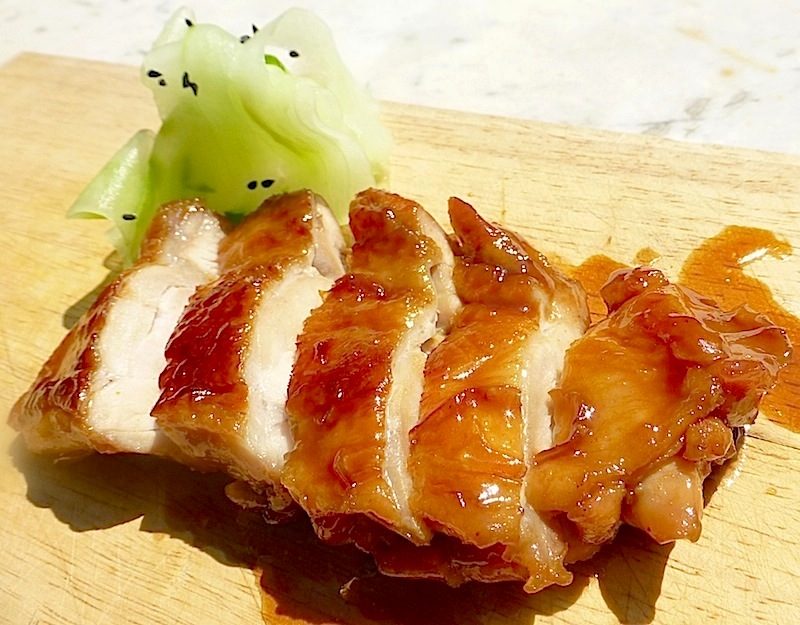This is the Breakfast Club’s favourite way to cook this Japanese classic. Not really a recipe as such, rather an understanding of how to go about it and why.
Simply have on hand the following ingredients.
INGREDIENTS
Mirin
Japanese Soy sauce
Sake
Brown sugar
Ginger, peeled and very thinly sliced.
That which is about to be teriyaki-ed.
In this case I used 4 chicken leg and thighs pieces still attached, skin on, bone out. Jonny’s favourite! However, you can also use this technique to make Teriyaki salmon, tofu, anything!
Using this technique, you put together your teriyaki meal in the fry pan on the spot. That is, you do not pre-make your teriyaki sauce. It absolutely tastes better this way. Take Jonny, our (currently) 10 year old. We wake earlier than the rest of the family (slobs) and indulge in foodstuff. We call it the ‘Breakfast Club’. Jonny is one of my respected go-to guys when needing an opinion on food. Haggis, ox tongue, chilli sauce are tasted and reported to me as equally considered as Bolognese, schnitzel and ice cream. It’s not a kiddy thing, more like the honesty of youth combined with a palate I respect. I think he may be working me over for a play station, but for now, he can believe in Santa and I will have the Breakfast Club.
This recipe, or rather technique, is Jonny’s favourite way that I have cooked teriyaki over his past 7 years of eating solids. Him, not me.
Why I think that this is the best method, is because you creep up on the desired flavour. You’re juggling all the components and tuning them up or down. Whereas, pre-making the sauce means that you’re committed to the ratios of sweetness, saltiness and umami well before you’ve even bought the chook (in this case). Furthermore, building the sauce in the pan around the main component allows you to taylor to the whole meal. Are my cucumbers particularly sweet or salty? Better back off the soy in the teriyaki, in that case.
YOU WILL NEED
A non-stick, heavy based fry pan with high sides. Very preferably one that barely fits all the chicken.
Tongs
Kitchen paper
METHOD
Place the 4 chicken thigh leg pieces (In Australia, we call them Maryland) skin down in the cold non-stick fry pan. Place it on a medium heat and watch and wait until things begin to sizzle and splutter as the chicken fat is rendered and starts to fry the skin, much like you had added oil to the pan in the first place.
Remove the chicken fat by taking a pair of tongs and mopping up the fat using absorbent kitchen paper.
A tip: keep these fat soaked wads, crammed into take-away containers in the freezer until you need a fire starter for your next fire. Jonny and I thought of this and it really works! Nearly burned down the house.
Once the chicken skin is brown and looking /feeling crispy, maybe 15 minutes at a constant medium sizzle (you will have to watch and regulate the heat to maintain this) turn the chicken over, turn the heat to maximum and add say 3-4 slices of ginger, and as a starting point, about a quarter cup each of mirin, soy, sake and sugar. Watch it, with the pan uncovered and cook, with the sauce bubbling and foaming around the chicken, until the meat is cooked through, and the sauce reduced to a glaze, coating the chicken. This could take roughly a further 10-15 minutes. While the chicken cooks, you have to watch and attend your cooking and balance the following, to suit your taste:
How cooked through the chicken is
The sweetness of the sauce (sugar)
Saltiness (soy)
Other flavours (mirin and sake)
Add any of the sauce ingredients as needed, and after the chicken has been on the heat for at least 20 minutes (no chance of eating undercooked chicken) taste, taste, taste… adjust, adjust, adjust… see, see, see… It tastes good, doesn’t it?
If the sauce is becoming too concentrated before the chicken is cooked, add splashes of water to the pan if needed.
When the chicken is done, remove the chicken and slice, drizzling over the remaining teriyaki sauce from the pan.
Serve with simple boiled rice and pickled cucumbers, sprinkled with sesame seeds.
Use exactly the same technique and approach to cooking teriyaki tofu and snow peas, or other meats or seafood. First sauté the main component, and then add the sauce ingredients and reduce to a glaze, making sure that everything is cooked through. Add the snow peas towards the end of the cooking, and serve.
